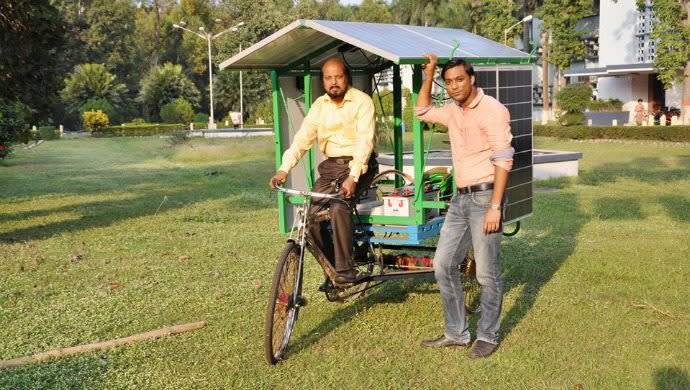This Indian scientist grows solar panels on trees
A solar tree that takes up only four square feet of space and produces about 5KW of power, enough to power five households
You’ve probably read the story of Cochin International Airport in Kerala, India, the world’s first airport fully powered by solar panels. Its 12 MW solar power plant — comprising 46,150 panels laid across 45 acres of land near cargo complex — produces 50,000-60,000 units of electricity per day, used by the airport across all its operational functions.
While heading for the airport the other day, I had a glimpse of the large number of solar panels. I wondered: if this can be replicated in other airports, India could save a lot on energy costs and reduce its dependence on fossil fuels, thereby helping save the ecosystem.
No doubt, solar energy is the way forward, and many innovations are happening that contribute to a better environment. The same also goes for innovations that make basic needs more accessible even for the last-mile user. Take for instance Facebook’s successful test of its high-altitude, long-endurance solar airplane that aims to give access to affordable Internet to everyone, including those living in hard-to-reach locations.
Developing economies, particularly countries like India, will greatly benefit from alternative energy sources, wherein people can go off-grid or even become net producers of power, contributing back to the grid. As part of this goal, governments provide subsidies to set up solar panels and wind turbines on house premises and farm lands.
However, there is still reluctance to embrace solar energy, as it requires a costly initial investment and regular maintenance, thus making it unfeasible for people living in villages and remote areas. Plus, it requires a large land area to build solar panels for industrial and agricultural purposes. In addition, urban dwellers don’t want to come out of their comfort zones and cease reliance on the grid.
Must Read: No black magic, this student has invented an apparatus that can produce water from thin air
Sibnath Maity, an Indian scientist has come up with a unique system that will address the chief concern associated with solar energy: the need for land. He has designed a ‘solar power tree’ that takes up only four square feet of land space, and that it can produce about 3 KW of power — enough to power five households. It resembles a tree with branches at different tiers and could be squeezed into rooftops and highways.

With his invention, Maity, who is Chief Scientist at the Central Mechanical Engineering Research Institute (CMERI), aims to give wings to the dream of millions of villagers who have been deprived of electricity for long.
“More than 80 per cent of Indians live in villages, most of which still don’t have access to electricity,” Maity told e27. “It is not feasible for the government to get electricity into villages as it is costly.”
“Solar energy is the need of the hour; however, people are reluctant to set up solar panels as it is expensive, too. Our life-changing solar tree is aimed at such villages,” he added.
Also Read: Li-Fi-enabled solar panels: The next revolution for digital India
Maity started working on the solar tree back in 2006, but he did not get much appreciation for his hard work until the central government noticed his invention and a Union Minister inaugurated one of his solar trees. “Eventually, my hard work paid off when Union Minister Dr. Harshvardhan inaugurated one of the solar trees built in Delhi,” he said.
For states like Bihar and Bengal, where electricity has yet to reach to the hinterlands, the solar tree is a godsend. Bizarre it may seem, even today in India there are villagers who walk kilometres to adjacent villages fortunate enough to have electricity, just to recharge their mobile phones. And the government’s ambitious dream of ‘electricity for all’ is nowhere close to reality.
“This is going to benefit states like Bengal, Bihar and Odisha,” said Maity. “I got a request from a farmer in Berhampur in Odisha to set up a solar tree, capable of producing 5KW of power for him to run a motor pump in his farm. We hope to see more such requests come in, moving forward.”
Maity admits that at INR 5 lakh (US$ 7,500), a solar tree capable of producing 5KW power is costly, but with the huge government subsidy it can be made affordable. “The cost depends on the requirement. If you need just a 3KW solar tree, it costs INR 3 lakh (US$ 4,500). Some state governments provide up to 30 per cent subsidy for alternative energy setups, while some others 80 per cent. On the top of it, central government also provides some grants. So it is not going to burn a big hole in people’s pocket.”
As of today, Maity has erected six solar trees in different villages in India. He is receiving queries from places like Lakshadeep and Andaman Nicobar (two Indian archipelagos), where land availability is a huge issue.

Sibnath Maity on his portable solar pump
“Unlike other solar panels, we promise 100 per cent efficiency. Plus, it does not need regular maintenance and has a long life. We want to see the entire India illuminated in the near future,” concluded Maity, who had previously designed a portable solar pump and a three-wheeler solar vehicle.
—-
Image Credits: Sibnath Maity
The post This Indian scientist grows solar panels on trees appeared first on e27.



